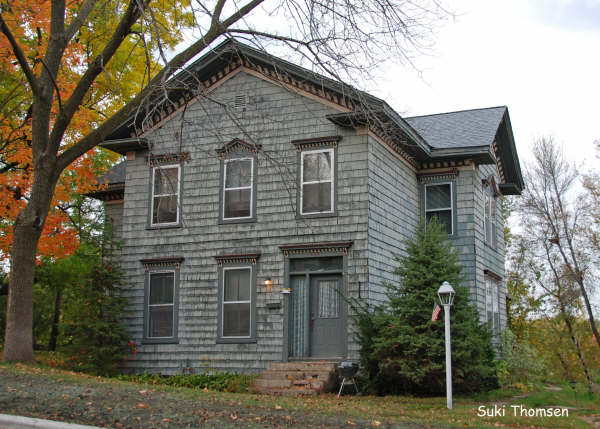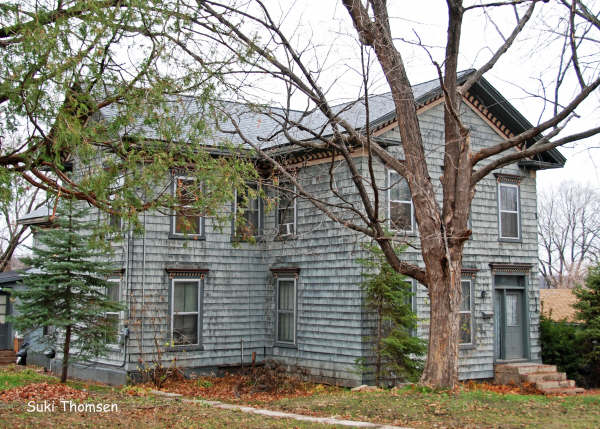Landmark Site
James & Harriet Anderson House
The evidence suggests that a part of this prominent and stately Greek Revival style house was built in the early 1860s, with compatible additions over the next decade. The tax assessor, making his rounds in 1862, ascribed a value of $100 to the lot, and $450 to the building on it. By 1865, the assessed value of the building had risen to $800 while the lot remained at the value of $100. Five years later, in 1870, the assessor assigned a value of $300 to the lot, and a value of $1,200 to the house. The two Bird’s Eye View maps of Stillwater seem to indicate the back east-west gable part of the house was not there in 1870, but was there in 1879. The house is a mixture of Greek Revival style characteristics from the 1850s, and Italianate style elements from the 1860s and ‘70s.
James and Harriet Anderson purchased the property in March of 1861, and it appears they began building this substantial house overlooking the city the following year. She was to occupy the home for the next fifty years.
James S. Anderson was born at Marshalltown, West Virginia, on February 4th, 1826. When he was 12, his family moved to Burlington, Iowa, where he lived for 8 years, coming to Stillwater as one of its earliest residents in 1846. In 1852, he married Harriet T. McDonald at St. Louis by whom he had four children. One son, Robert M., like his father, became a lumberman, and resided for some years nearby at 206 South Fifth Street.
Upon arriving in Stillwater, James Anderson began working with Elias McKean, a prominent lumberman in the area. In 1868, he and Josiah Staples engaged in blacksmithing for a time. However, the next year, 1869, James formed a partnership with William McKusick, John G. Nelson, and Alexander Johnson, under the firm name of McKusick, Anderson, & Co. which built and operated a large saw mill on the Wisconsin side of the St. Croix River across from Stillwater. In 1874, Anderson joined with John O’Brien to form another logging firm of Anderson & O’Brien. He had several other business affiliations in the lumbering industry, including a position as a director of the Lumberman’s National Bank.
(This was a neighborhood affair: Alexander Johnson lived at 119 West Chestnut Street. John O’Brien resided at 306 West Olive Street. Another partner, John G. Nelson lived at 604 North Fourth Street, and a fourth partner, Josiah Staples lived at 402 North Fourth Street. See the histories of those four houses on this website.)
On Wednesday, May 6th, 1885, at the age of 59, in the prime of his life, Anderson was inspecting the machinery in his saw mill. As the newspaper recorded it:
"The attention of Mr. Anderson, who was standing by, was attracted by the ‘singing’ of a saw in another part of the mill, and he started to ascertain what the trouble was. Shortly afterward, Mr. Egaard [the mill superintendent] was startled by an agonizing cry for help, and a peculiar thumping at the rear end of the mill. Instantly he shouted to the engineer to shut off steam, and rushing up a flight of stairs in the direction whence the cry came, he found Mr. Anderson in a sitting position on a middle deck, his right arm lying beside him, face covered with blood and clothing torn in shreds from the upper part of the right side of his body. The wounded man managed to ejaculate ‘I am killed!’ On the arrival of a surgeon Mr. Anderson was conveyed to his residence on Chestnut street, where a surgical operation was performed, previous to which, however, while suffering mortal agony, Mr. Anderson dictated the terms of his will to his solicitor, J. N. Castle, and after the instrument was prepared it was duly signed, acknowledged and witnessed. An examination showed that in addition to the dismemberment of his arm, he had sustained the fracture of two ribs on the left side and other minor injuries. . . [in the mill] his position allowed the sleeve of his rubber coat to catch between the belt and revolving pulley. Then his wrist was firmly caught between the two. No effort could save him, and he was forced to endure the agonizing torture of having his arm slowly pulled from the socket. . ."
Anderson contracted pneumonia, and died of his injuries two days later.
The 1900 Census lists his wife, Harriet, living at 220 West Chestnut Street with her servant, Annie Kramry, age 22, and her coachman, John Vieaue, age 30. Harriet listed her occupation as a "dealer in real estate." She continued living in the house until 1901 when she moved to her son’s house across the street at 206 South Fifth Street
By 1908, 220 West Chestnut had a new occupant, Dr. Sidney Boleyn and his wife, Helen, and their 16-year-old servant, Elsie Rutherford. Sidney practiced medicine in Stillwater for decades and remained in 220 West Chestnut Street into the late 1940s.
Sometime in the 1950s or ‘60s, the house was converted into apartments, and it remains an apartment house today. But the original stateliness of this gracious old pioneer home overlooking the city can still be glimpsed and perhaps some future owner will appreciate its role in Stillwater history and restore the home to its former elegance.
Source(s): Information complied by Donald Empson, Empson Archives on 2/24/2009. Building date and value is from the original annual tax assessors’ rolls, 1862-1870 (on microfilm in the St. Croix Collection, Stillwater Public Library); the Bird’s Eye View maps of Stillwater for 1870 and 1879 have drawings of the house. The Stillwater City Directories confirmed the residents of the house. W.H.C. Folsom’s book: Fifty Years in the Northwest has a biography of Anderson, which is repeated in Augustus B. Easton: History of the St. Croix Valley. The newspaper account of Anderson’s death is in the Messenger of May 9, 1885. The U.S. Census records from 1870 to 1930 were useful. E.L. Roney’s book: Looking Backward has information about the area known today as Chestnut Hill.
Washington County Parcel Identification Number (PIN): 2803020420143
Common Property Name: James & Harriet Anderson House
Neighborhood: South Hill
State Historic Preservation Office Inventory Number: WA-SWC-142
Construction Date: 1862
Architectural Style: Greek Revival

